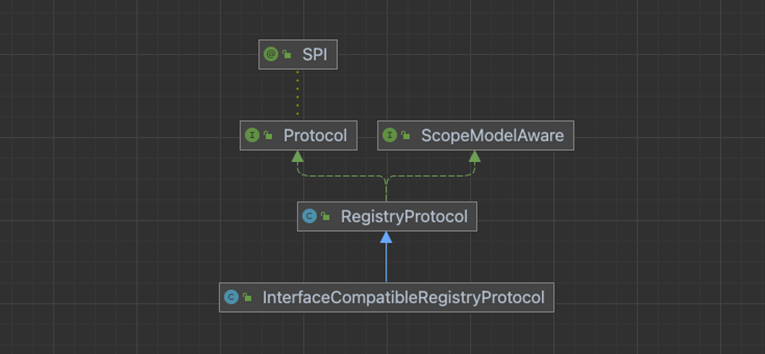基于Dubbo 3.1,详细介绍了Dubbo服务的发布与引用的源码。
此前我们学习了createInvokerForRemote方法中的Wrapper有哪些以及作用,接下来我们将会的学习真正的本地、应用级别、接口级别的Protocol的引入逻辑,以及创建Proxy服务接口代理对象的逻辑。
Dubbo 3.x服务引用源码:
- Dubbo 3.x源码(11)—Dubbo服务的发布与引用的入口
- Dubbo 3.x源码(18)—Dubbo服务引用源码(1)
- Dubbo 3.x源码(19)—Dubbo服务引用源码(2)
- Dubbo 3.x源码(20)—Dubbo服务引用源码(3)
- Dubbo 3.x源码(21)—Dubbo服务引用源码(4)
Dubbo 3.x服务发布源码:
- Dubbo 3.x源码(11)—Dubbo服务的发布与引用的入口
- Dubbo 3.x源码(12)—Dubbo服务发布导出源码(1)
- Dubbo 3.x源码(13)—Dubbo服务发布导出源码(2)
- Dubbo 3.x源码(14)—Dubbo服务发布导出源码(3)
- Dubbo 3.x源码(15)—Dubbo服务发布导出源码(4)
- Dubbo 3.x源码(16)—Dubbo服务发布导出源码(5)
- Dubbo 3.x源码(17)—Dubbo服务发布导出源码(6)
1 InjvmProtocol本地引入协议
这是本地引入的协议实现,其代码很简单,就是构建一个InjvmInvoker对象实例,同时内部保存着本地导出的服务缓存exporterMap。
本地引入并没有涉及到注册中心以及网络服务器客户端。
/*** AbstractProtocol的方法*/
@Override
public <T> Invoker<T> refer(Class<T> type, URL url) throws RpcException {//该方法由子类实现return protocolBindingRefer(type, url);
}
/*** InjvmProtocol的方法*/
@Override
public <T> Invoker<T> protocolBindingRefer(Class<T> serviceType, URL url) throws RpcException {//返回一个InjvmInvoker实例,同时内部保存着本地导出的服务缓存exporterMapreturn new InjvmInvoker<T>(serviceType, url, url.getServiceKey(), exporterMap);
}
2 RegistryProtocol应用级远程服务引入协议
应用级服务远程协议以service-discovery-registry开头,其对应的Protocol实现就是RegistryProtocol。RegistryProtocol的refer方法大概步骤为:
- 调用getRegistryUrl方法获取注册中心协议url,如果是RegistryProtocol的实现则将url更换为应用级服务发现协议url,如果是InterfaceCompatibleRegistryProtocol的实现则尝试url更换为真实注册中心协议url。
- 调用getRegistry方法获取注册中心操作类Registry。基于Dubbo SPI机制根据url的协议加载具体的注册中心操作类,service-discovery-registry对应着ServiceDiscoveryRegistry,zookeeper对应着ZookeeperRegistry。
- 如果服务类型为RegistryService,那么通过proxyFactory基于registry实例获取Invoker。
- 获取group属性,即想要引用的服务分组。如果配置了分组,调用doRefer方法基于MergeableCluster继续引用服务,否则调用doRefer方法基于基于服务参数指定的cluster继续引用服务。
/*** RegistryProtocol的方法** @param type 服务类型* @param url 远程注册中心服务协议地址,以service-discovery-registry或者registry作为协议*/
@Override
@SuppressWarnings("unchecked")
public <T> Invoker<T> refer(Class<T> type, URL url) throws RpcException {/** 1 获取注册中心协议url。*/url = getRegistryUrl(url);/** 2 获取注册中心操作类Registry* 基于Dubbo SPI机制根据url的协议加载具体的注册中心操作类,service-discovery-registry对应着ServiceDiscoveryRegistry* zookeeper对应着ZookeeperRegistry*/Registry registry = getRegistry(url);//如果服务类型为RegistryServiceif (RegistryService.class.equals(type)) {//基于registry实例获取Invokerreturn proxyFactory.getInvoker((T) registry, type, url);}// group="a,b" or group="*"//获取服务引用属性mapMap<String, String> qs = (Map<String, String>) url.getAttribute(REFER_KEY);//获取group,即想要引用的服务分组String group = qs.get(GROUP_KEY);//如果配置了分组if (StringUtils.isNotEmpty(group)) {if ((COMMA_SPLIT_PATTERN.split(group)).length > 1 || "*".equals(group)) {//调用doRefer方法基于MergeableCluster继续引用服务return doRefer(Cluster.getCluster(url.getScopeModel(), MergeableCluster.NAME), registry, type, url, qs);}}//基于Dubbo SPI获取Cluster实现,Cluster用于支持集群容错策略Cluster cluster = Cluster.getCluster(url.getScopeModel(), qs.get(CLUSTER_KEY));//调用doRefer方法基于基于服务参数指定的cluster继续引用服务return doRefer(cluster, registry, type, url, qs);
}
2.1 getRegistryUrl获取注册中心url
该方法会判断当前协议如果已经是应用级服务发现协议,即service-discovery-registry,那么直接返回原协议。否则,url添加registry={protocol}参数,并且协议设置为service-discovery-registry协议,即应用级服务发现协议。
即RegistryProtocol#getRegistryUrl方法主要是将注册中心协议url更换为应用级服务发现协议url。
/*** RegistryProtocol的方法** @param url 远程服务发现协议url* @return 注册中心协议url*/
protected URL getRegistryUrl(URL url) {//如果是应用级服务发现协议,即service-discovery-registry,那么直接返回原协议if (SERVICE_REGISTRY_PROTOCOL.equals(url.getProtocol())) {return url;}//否则,url添加registry={protocol}参数,并且协议设置为service-discovery-registry协议return url.addParameter(REGISTRY_KEY, url.getProtocol()).setProtocol(SERVICE_REGISTRY_PROTOCOL);
}
2.2 getCluster获取集群对象
//基于Dubbo SPI获取Cluster实现,Cluster用于支持集群容错策略
Cluster cluster = Cluster.getCluster(url.getScopeModel(), qs.get(CLUSTER_KEY));
集群对象Cluster,实际上Cluster不仅仅有容错功能,因为其还代表着Dubbo十层架构中的集群层,因此,集群路由、负载均衡、发起RPC调用、失败重试、服务降级都是在该层实现的。但是这些功能不都是由Cluster接口实现的,而是由集群层的其他核心接口实现,例如Directory 、 Router 、 LoadBalance。
Cluster通过基于Dubbo SPI机制获取,同时还会被wrapper包装,可以通过属性cluster设置集群方式,可选:failover/failfast/failsafe/failback/forking,如不设置默认failover,即FailoverCluster。
static Cluster getCluster(ScopeModel scopeModel, String name) {//允许wrapperreturn getCluster(scopeModel, name, true);
}static Cluster getCluster(ScopeModel scopeModel, String name, boolean wrap) {//如果name为空,那么默认failoverif (StringUtils.isEmpty(name)) {name = Cluster.DEFAULT;}//基于Dubbo SPI获取,可能会经过wrapperreturn ScopeModelUtil.getApplicationModel(scopeModel).getExtensionLoader(Cluster.class).getExtension(name, wrap);
}
由于允许wrapper包装,那么实际返回的Cluster并不是FailoverCluster,而是MockClusterWrapper。

2.3 doRefer执行远程引用服务
该方法执行远程引用服务,RegistryProtocol和InterfaceCompatibleRegistryProtocol对于该方法的大概方法骨架是一样的,只是某些方法实现不同。
大概步骤为:
- 根据消费方的服务引用配置构建服务消费invoker,协议为服务消费配置的protocol属性,表示只调用指定协议的服务提供方,其它协议忽略,默认值consumer。随后将当前consumerUrl存入注册中心协议url的属性缓存中,key为CONSUMER_URL。
- 调用getMigrationInvoker方法获取可迁移Invoker。应用级服务引用RegistryProtocol的getMigrationInvoker方法将会返回ServiceDiscoveryMigrationInvoker。而对于接口级注服务引用InterfaceCompatibleRegistryProtocol来说,将会返回MigrationInvoker。
- 调用interceptInvoker方法拦截invoker。实际上就是获取所有RegistryProtocolListener然后执行他们的onRefer,可用于在服务引用时更改invoker的行为和配置。
/*** RegistryProtocol的方法* 引用服务** @param cluster 支持不同容错策略的Cluster,默认FailoverCluster* @param registry 注册中心操作类。例如ServiceDiscoveryRegistry、ZookeeperRegistry* @param type 服务接口* @param url 注册中心协议url* @param parameters 服务引用参数* @return Invoker*/
protected <T> Invoker<T> doRefer(Cluster cluster, Registry registry, Class<T> type, URL url, Map<String, String> parameters) {//获取消费者属性,即attributes属性,内部包括:serviceModel、refer(服务引用参数)、scopeModelMap<String, Object> consumerAttribute = new HashMap<>(url.getAttributes());consumerAttribute.remove(REFER_KEY); //移除refer,因为方法参数已经传递了//获取protocol属性,只调用指定协议的服务提供方,其它协议忽略,默认值consumerString p = isEmpty(parameters.get(PROTOCOL_KEY)) ? CONSUMER : parameters.get(PROTOCOL_KEY);//构建服务配置urlURL consumerUrl = new ServiceConfigURL(//协议,如不指定默认consumerp,//用户名null,//密码null,//ipparameters.get(REGISTER_IP_KEY),//端口0,path服务接口全路径0, getPath(parameters, type),parameters,consumerAttribute);//将当前consumerUrl存入注册中心协议url的属性缓存中,key为CONSUMER_URLurl = url.putAttribute(CONSUMER_URL_KEY, consumerUrl);/** 获取可迁移Invoker*/ClusterInvoker<T> migrationInvoker = getMigrationInvoker(this, cluster, registry, type, url, consumerUrl);//拦截invokerreturn interceptInvoker(migrationInvoker, url, consumerUrl);
}
2.3.1 getMigrationInvoker获取可迁移Invoker
对于使用了应用级注册中心协议的RegistryProtocol来说,getMigrationInvoker方法将会返回一个ServiceDiscoveryMigrationInvoker。而对于接口级注册中心协议的InterfaceCompatibleRegistryProtocol来说,将会返回MigrationInvoker,他们都是可迁移Invoker。其中ServiceDiscoveryMigrationInvoker继承了MigrationInvoker。

RegistryProtocol:
/*** RegistryProtocol的方法* 获取可迁移Invoker** @param registryProtocol 注册表协议* @param cluster 集群* @param registry 注册中心* @param type 接口类型* @param url 注册中心协议url* @param consumerUrl 消费者url* @return 可迁移Invoker*/
protected <T> ClusterInvoker<T> getMigrationInvoker(RegistryProtocol registryProtocol, Cluster cluster, Registry registry, Class<T> type, URL url, URL consumerUrl) {return new ServiceDiscoveryMigrationInvoker<T>(registryProtocol, cluster, registry, type, url, consumerUrl);
}InterfaceCompatibleRegistryProtocol:
/*** InterfaceCompatibleRegistryProtocol的方法* 获取可迁移Invoker** @param registryProtocol 注册表协议* @param cluster 集群* @param registry 注册中心* @param type 接口类型* @param url 注册中心协议url* @param consumerUrl 消费者url* @return 可迁移Invoker*/
@Override
protected <T> ClusterInvoker<T> getMigrationInvoker(RegistryProtocol registryProtocol, Cluster cluster, Registry registry, Class<T> type, URL url, URL consumerUrl) {//ClusterInvoker<T> invoker = getInvoker(cluster, registry, type, url);//获取MigrationInvokerreturn new MigrationInvoker<T>(registryProtocol, cluster, registry, type, url, consumerUrl);
}所谓迁移,实际上是Dubbo 3的概念,因为Dubbo 3引入应用级服务发现,因此2.x 版本升级到3.x版本的时候,将会涉及到从接口级服务发现迁移至应用级服务发现。
Dubbo3的消费者和提供者一样,具备同时发现 2.x 与 3.x 提供者地址列表的能力,即服务双订阅,而这个可迁移Invoker,实际上表示消费者能够自动选择2.x 或者 3.x中的一种来消费。
在 Dubbo 3 之前地址注册模型是以接口级粒度注册到注册中心的,而 Dubbo 3 全新的应用级注册模型注册到注册中心的粒度是应用级的。从注册中心的实现上来说是几乎不一样的,这导致了对于从接口级注册模型获取到的 invokers 是无法与从应用级注册模型获取到的 invokers 进行合并的。为了帮助用户从接口级往应用级迁移,Dubbo 3 设计了 Migration 机制,基于三个状态的切换实现实际调用中地址模型的切换。这就是迁移的含义,而可迁移,就是可以在这三个状态之间动态转换。
三种迁移状态:FORCE_INTERFACE(强制接口级),APPLICATION_FIRST(应用级优先)、FORCE_APPLICATION(强制应用级)。
- FORCE_INTERFACE:只启用兼容模式下接口级服务发现的注册中心逻辑,调用流量 100% 走原有流程。
- APPLICATION_FIRST:开启接口级、应用级双订阅,运行时根据阈值和灰度流量比例动态决定调用流量走向。
- FORCE_APPLICATION:只启用新模式下应用级服务发现的注册中心逻辑,调用流量 100% 走应用级订阅的地址。
相关文档:
- https://dubbo.apache.org/zh/docs3-v2/java-sdk/upgrades-and-compatibility/service-discovery/
- https://dubbo.apache.org/zh/docs3-v2/java-sdk/upgrades-and-compatibility/service-discovery/migration-service-discovery/#3-consumer-端升级过程
- https://dubbo.apache.org/zh/docs3-v2/java-sdk/upgrades-and-compatibility/service-discovery/service-discovery-rule/
2.3.2 interceptInvoker拦截invoker
该方法尝试加载所有的RegistryProtocolListener定义,这些定义用于通过与已定义的交互来控制调用程序的行为,然后使用这些侦听器来更改MigrationInvoker的状态和行为,最后返回MigrationInvoker。
说白了,引入RegistryProtocol监听器是为了让用户有机会定制或更改RegistryProtocol的导出和引用行为。
该方法的大概逻辑为:
- 根据url参数registry.protocol.listener作为扩展名获取RegistryProtocolListener的Dubbo SPI实现,如果没有该参数则获取全部实现列表。
- 遍历所有RegistryProtocolListener,依次调用他们的onRefer方法,用于更改invoker。
当前版本可用的监听器仅一个MigrationRuleListener,它用于通过动态更改规则来控制迁移行为,同时它的onRefer方法才是真正的服务引入的方法,关于它的源码我们下文分析。
/*** RegistryProtocol的方法* <p>* 拦截Invoker* <p>* 该方法尝试加载所有的RegistryProtocolListener定义,这些定义用于通过与已定义的交互来控制调用程序的行为,然后使用这些侦听器来更改MigrationInvoker的状态和行为。* 当前版本可用的监听器是MigrationRuleListener,它用于通过动态更改规则来控制迁移行为。** @param invoker MigrationInvoker,它确定要使用哪种类型的调用程序列表* @param url 原始url,例如service-discovery-registry://47.94.229.245:2181/org.apache.dubbo.registry.RegistryService?REGISTRY_CLUSTER=demo1&application=demo-consumer&dubbo=2.0.2&pid=8228®istry=zookeeper®istry-type=service®istry.type=service&timeout=20000×tamp=1666884631226* @param consumerUrl 表示当前接口及其配置的使用者url* @param <T> 服务定义* @return 传入的MigrationInvoker*/
protected <T> Invoker<T> interceptInvoker(ClusterInvoker<T> invoker, URL url, URL consumerUrl) {//根据url参数registry.protocol.listener作为扩展名获取RegistryProtocolListener的Dubbo SPI实现,如果没有该参数则获取全部实现列表//当前版本可用的监听器仅一个MigrationRuleListener,它用于通过动态更改规则来控制迁移行为。List<RegistryProtocolListener> listeners = findRegistryProtocolListeners(url);//没有监听器直接返回if (CollectionUtils.isEmpty(listeners)) {return invoker;}//遍历所有监听器,执行监听器的onRefer方法for (RegistryProtocolListener listener : listeners) {listener.onRefer(this, invoker, consumerUrl, url);}return invoker;
}
3 InterfaceCompatibleRegistryProtocol接口级远程服务引入协议
接口级服务远程导出协议以registry开头,其对应的Protocol实现就是InterfaceCompatibleRegistryProtocol。
实际上InterfaceCompatibleRegistryProtocol继承了RegistryProtocol,大部分代码都是一样的,例如refer引入服务的方法,仅仅是一些细微的代码不一致。我们来看看它在refer过程中的特有的方法。

3.1 getRegistryUrl获取注册中心url
该方法根据远程服务协议url获取注册中心url,会对远程服务发现协议url进行处理、还原。获取url中的registry属性,也就是真实的注册中心协议,例如zookeeper,默认dubbo,然后替换掉registry协议并删除registry属性返回。
即InterfaceCompatibleRegistryProtocol#getRegistryUrl方法主要是将远程服务发现协议url更换为真实注册中心协议url。
/*** InterfaceCompatibleRegistryProtocol的方法* * @param url 远程服务发现协议url* @return*/
@Override
protected URL getRegistryUrl(URL url) {return URLBuilder.from(url)//获取url中的registry属性,也就是真实的注册中心协议,例如zookeeper,默认dubbo,然后替换掉registry协议.setProtocol(url.getParameter(REGISTRY_KEY, DEFAULT_REGISTRY))//删除registry属性.removeParameter(REGISTRY_KEY).build();
}4 getProxy创建服务接口代理对象
在进行了服务引入并创建了服务引入Invoker之后,在最后会调用proxyFactory#getProxy方法根据invoker创建一个服务接口代理对象返回。
这里的proxyFactory是ProxyFactory的自适应扩展实现,即ProxyFactory$Adaptive,也就是说会根据传入的url中的参数proxy的值选择对应的代理工厂实现类,而默认实现就是JavassistProxyFactory,因为它速度更快。最后通过真正的代理工厂实现类的getProxy方法创建服务代理对象。
在此前学习Dubbo服务发布的时候,同样是调用proxyFactory#getInvoker方法创建的一个代理Invoker实例对象的。
/*** ProxyFactory$Adaptive的方法* 创建服务代理对象* @param arg0 服务引入invoker* @param arg1 是否是泛型接口* @return 服务代理对象* @throws org.apache.dubbo.rpc.RpcException*/
public java.lang.Object getProxy(org.apache.dubbo.rpc.Invoker arg0, boolean arg1) throws org.apache.dubbo.rpc.RpcException {if (arg0 == null) throw new IllegalArgumentException("org.apache.dubbo.rpc.Invoker argument == null");if (arg0.getUrl() == null)throw new IllegalArgumentException("org.apache.dubbo.rpc.Invoker argument getUrl() == null");//注册中心协议urlorg.apache.dubbo.common.URL url = arg0.getUrl();//获取url中的proxy参数,默认javassistString extName = url.getParameter("proxy", "javassist");if (extName == null)throw new IllegalStateException("Failed to get extension (org.apache.dubbo.rpc.ProxyFactory) name from url (" + url.toString() + ") use keys([proxy])");ScopeModel scopeModel = ScopeModelUtil.getOrDefault(url.getScopeModel(), org.apache.dubbo.rpc.ProxyFactory.class);//基于Dubbo SPi机制查找指定名字的实现,默认JavassistProxyFactoryorg.apache.dubbo.rpc.ProxyFactory extension = (org.apache.dubbo.rpc.ProxyFactory) scopeModel.getExtensionLoader(org.apache.dubbo.rpc.ProxyFactory.class).getExtension(extName);//通过ProxyFactory的getProxy方法获取服务代理对象return extension.getProxy(arg0, arg1);
}4.1 JavassistRpcProxyFactory#getProxy
基于Javassist创建给定接口的代理对象,调用处理器为InvokerInvocationHandler,内部封装了invoker的调用。javassist创建失败之后,回退到基于jdk动态代理的方式创建代理对象。
/*** JavassistRpcProxyFactory的方法** 将invoker包装成一个服务接口的代理对象实例** @param invoker 服务引入invoker* @param interfaces 服务接口* @return 服务接口的代理对象实例* @param <T>*/
@Override
@SuppressWarnings("unchecked")
public <T> T getProxy(Invoker<T> invoker, Class<?>[] interfaces) {try {//基于Javassist创建给定接口的代理对象,调用处理器为InvokerInvocationHandler,内部封装了invoker的调用return (T) Proxy.getProxy(interfaces).newInstance(new InvokerInvocationHandler(invoker));} catch (Throwable fromJavassist) {// try fall back to JDK proxy factorytry {//javassist创建失败之后,回退到基于jdk动态代理的方式创建代理对象T proxy = jdkProxyFactory.getProxy(invoker, interfaces);logger.error("Failed to generate proxy by Javassist failed. Fallback to use JDK proxy success. " +"Interfaces: " + Arrays.toString(interfaces), fromJavassist);return proxy;} catch (Throwable fromJdk) {logger.error("Failed to generate proxy by Javassist failed. Fallback to use JDK proxy is also failed. " +"Interfaces: " + Arrays.toString(interfaces) + " Javassist Error.", fromJavassist);logger.error("Failed to generate proxy by Javassist failed. Fallback to use JDK proxy is also failed. " +"Interfaces: " + Arrays.toString(interfaces) + " JDK Error.", fromJdk);throw fromJavassist;}}
}
4.2 InvokerInvocationHandler调用处理器
InvokerInvocationHandler实现了InvocationHandler接口,所有对于代理对象的方法调用最终都会被转发到InvokerInvocationHandler的invoke方法上来,在该方法中能够获取到调用的接口方法和参数等信息,这样就是依靠内部的invoker对于真实的服务提供者实现发起本地或者远程调用了。
具体的发起调用的源码,我们在后面讲consumer服务调用的时候再详细分析。
public class InvokerInvocationHandler implements InvocationHandler {private static final Logger logger = LoggerFactory.getLogger(InvokerInvocationHandler.class);private final Invoker<?> invoker;private final ServiceModel serviceModel;private final String protocolServiceKey;public InvokerInvocationHandler(Invoker<?> handler) {this.invoker = handler;//consumerUrlURL url = invoker.getUrl();//协议服务key,格式为 {group}/{serviceName}:{version},例如greeting/org.apache.dubbo.demo.GreetingService:1.0.0this.protocolServiceKey = url.getProtocolServiceKey();this.serviceModel = url.getServiceModel();}/*** InvokerInvocationHandler的方法** 执行代理对象的方法的转发** @param proxy 在其上调用方法的代理实例** @param method 在代理实例上调用的接口方法** @param args 一个对象数组,包含在代理实例的方法调用中传递的参数值,如果接口方法不接受参数,则为null** @return 调用代理对象方法执行结果*/@Overridepublic Object invoke(Object proxy, Method method, Object[] args) throws Throwable {//对于object类的方法,直接反射调用if (method.getDeclaringClass() == Object.class) {return method.invoke(invoker, args);}//获取方法名和方法参数类型数组String methodName = method.getName();Class<?>[] parameterTypes = method.getParameterTypes();//特殊方法的调用,直接调用invoker对象的同名方法if (parameterTypes.length == 0) {if ("toString".equals(methodName)) {return invoker.toString();} else if ("$destroy".equals(methodName)) {invoker.destroy();return null;} else if ("hashCode".equals(methodName)) {return invoker.hashCode();}} else if (parameterTypes.length == 1 && "equals".equals(methodName)) {return invoker.equals(args[0]);}//构建一个RpcInvocation作为接口方法调用抽象,包含方法名字,接口名,方法参数等信息RpcInvocation rpcInvocation = new RpcInvocation(serviceModel, method.getName(), invoker.getInterface().getName(), protocolServiceKey, method.getParameterTypes(), args);if (serviceModel instanceof ConsumerModel) {rpcInvocation.put(Constants.CONSUMER_MODEL, serviceModel);rpcInvocation.put(Constants.METHOD_MODEL, ((ConsumerModel) serviceModel).getMethodModel(method));}//通过InvocationUtil.invoke方法来发起真正的远程or本地调用return InvocationUtil.invoke(invoker, rpcInvocation);}
}
5 总结
本次我们学习了Dubbo3.1版本的服务引入的总体流程,现在简单总结下:
- 首先是Dubbo服务引入的入口,在Dubbo 3.1中,它位于监听器DubboDeployApplicationListener#onApplicationEvent方法中,在spring容器启动的最后一个步也就是refresh方法内部最后的finishRefresh方法中,将会向所有监听器发布一个ContextRefreshedEvent事件,表示容器刷新完毕,此时就会触发这个方法的调用。在Dubbo3.1中,默认启动项目就会进行服务引入,即饿汉式。
- onApplicationEvent方法内部通过DefaultModuleDeployer#start方法开启服务的导出、引用等操作,最终在startSync方法内部的referServices方法中,将会获取全部的dubbo服务引入bean实例ReferenceConfig,然后依次进行服务引入。
- 服务引入的全流程在ReferenceConfig#createProxy方法中,该方法首先尝试创建invoker,也就是进行服务引入的逻辑。
- 服务引入分为本地引入和远程引入,本地引入的invoker内部不需要创建netty客户端,因为不会发送网络请求,而是直接调用本服务的接口,远程引入则会创建netty客户端,用以发送rpc请求。
- 对于远程引入,获取的是MigrationInvoker可迁移Invoker,用于dubbo2.x和dubbo3.x之间的接口级别和应用级别的服务发现迁移。
- 创建MigrationInvoker并没有真正涉及到服务的引入**,在interceptInvoker方法中,该方法将会对invoker应用MigrationRuleListener#onRefer方法,该方法才是真正的服务引入入口,MigrationRuleListener以及真正的服务引入的逻辑,我们后面学习。**
- 然后调用sproxyFactory#getProxy方法根据invoker创建一个服务接口代理对象返回,默认基于Javassist的代理。这样就完成了服务的引入。
后面我们将会继续学习MigrationRuleListener#onRefer方法,该方法才是真正的服务引入入口,MigrationRuleListener以及真正的服务引入的逻辑,以及服务迁移到底是个什么东西?我们后面学习。


 —— 检索数据)

 之 大模型LoRA指令微调实践)
)











 takes no arguments)

)